Sing to the World – Taiwanese graphic novel
[Tao Ting Pictures] Graphic Novel Column

Taiwanese image creators sometimes worry about whether their works will be accepted by the market - don't worry at all, because there is always a group of people in the world who you think are small but are actually huge.
(Animo)
Although Taiwan has a small land area, it has a rich natural environment, diverse history and culture, and has been in line with the international art and literary circles for many years. It has the capital to cultivate first-class creative talents. In recent years, graphic novels in Taiwan have been at the forefront of cultural trends, and their growth is only beginning to gain momentum. Signs of the rise of graphic novels include: the first "Comics for Adults - Graphic Novel Festival" was held in Taipei in 2019; classic works have been translated and published one after another (such as American masters Spiegelman and Eisner, French science fiction master Moebius, The famous Japanese artist Matsumoto Ichiro...the original work was published decades ago, but the traditional Chinese version was only published in recent years); creators from Taiwan and other countries frequently visit each other, and local works have won international awards...there are clues.
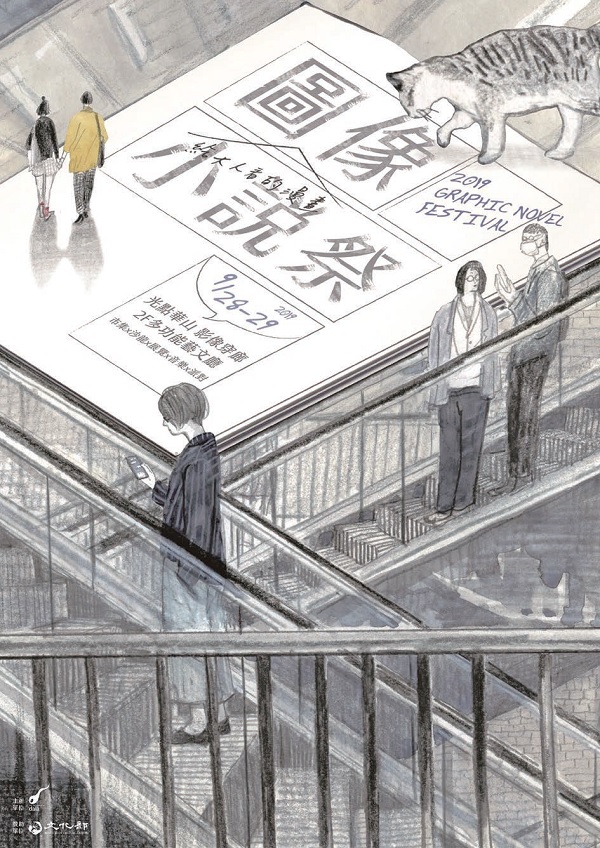
▲Picture source:https://images.app.goo.gl/t7NtRE5gNKQLEH766
When Generation Z (born between 1995 and 2012), who have both "literacy" and "image recognition", begins to enter the workplace, their appreciation and willingness to purchase graphic novels are lower than those of the traditional generation who are accustomed to reading pure text novels. Much higher, further securing the market for graphic novels created for adults. In the future, graphic novels in Taiwan may become a more mature and diverse important subculture.
This article introduces several representative creators whose works have gained international recognition and will lead future writers and works to a considerable extent.
Rifeng Old Street Squid Soup - Ruan Guangmin
Ruan Guangmin (1973-) grew up in Douliu, Yunlin, and came to the north to study and work after middle school. He is a local painter who emerged from a Japanese comic studio. He worked in the famous Lai Youxian Studio for many years and laid a strong practical foundation. From a living background in a rural town to a city, he has been commuting between different cities for many years to observe various scenes, and he has traveled in the design and advertising industry to make a living. These life experiences and experiences have enriched his creations.
"Dong Hua Chun Barber Salon" (2009) is Ruan Guangmin's famous work. I conceived the idea during my commute and sketched it out stroke by stroke at night after get off work. It took me three years to complete it. The inspiration for the story came when he saw an old-fashioned barber shop named "Dong Hua Chun" on the street during his commute, and he began to think about it: Assuming that Dong Hua Chun each represents one person, what kind of relationship would these three people have?
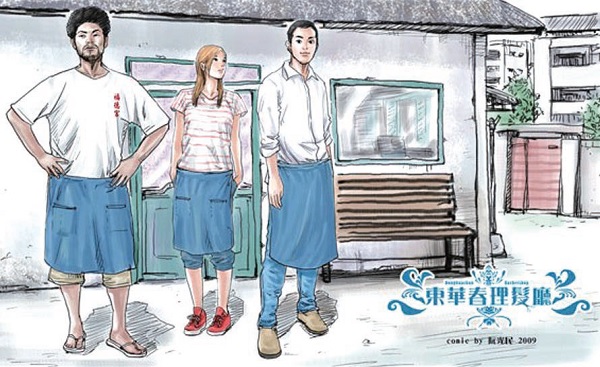
▲"Donghua Chun Barber Salon" by Ruan Guangmin. (Image Source:https://gnn.gamer.com.tw/detail.php?sn=73688)
In the story woven by Ruan Guangmin, Chen Zhen "Dong" opened a small barber shop when his wife Xiu "Chun" was pregnant. When his only son, Chen Xiaohua, was ten years old, Chen Zhendong abandoned his wife and son and left home, and there has been no news since. Twenty years later, Xiaohua runs a barber shop by himself. An unknown half-sister appears from the sky - the 19-year-old Yulan was entrusted to him before his father passed away. To make the situation more complicated, Xiaohua's recently hired assistant is a parolee who has just been released from prison.
From the grievances of the previous generation to the ties of the next generation, several protagonists have to decide whether to stay on the original track, or try to forgive, try to accept, and try to enter each other's world?
At the beginning of the story, a naughty neighborhood kid is teased by Xiaohua, thinking that the barber shop is haunted; in fact, it might as well be said that this is a story about emerging from the ghosts of close relatives and mistakes, and allowing the relationship to be reborn in the sun. In just one volume, Ruan Guangmin demonstrates the skill of "less is more". He advances the plot through dialogue and monologues, expresses the character's characteristics through vivid modeling, and brings out the atmosphere of the times with background details.
The origin of the series "Yong Jiu Gan Zai Shop" (2016) is closer to Ruan Guangmin's own childhood. When he was a child in the countryside of Douliu, his parents were busy with work, and he spent countless spare time in the "Ganzai Store" (an old-style grocery store) run by his grandfather. Yang Junlong, the protagonist of "Yong Jiu Gan Zai Shop", was raised by his grandfather. His ancestors were seriously ill and returned to their hometown to visit relatives. Later, they decided to give up their golden jobs in the city and came back to take over the old shop. Junlong's motivation is just like the title of the first volume: Protecting the heartwarming place - he wants this shop that will always leave a light for old customers to continue to shine.
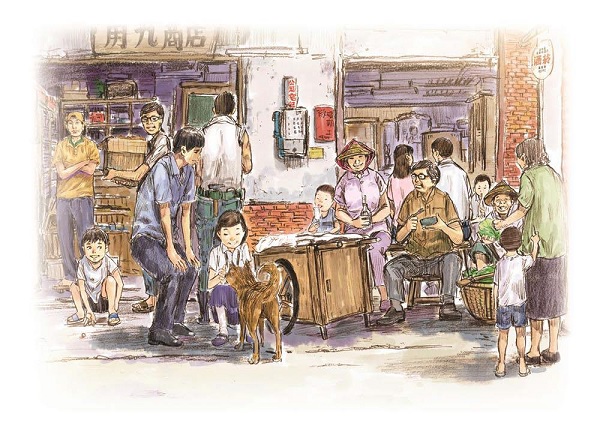
▲"Yongjiu Ganzi Shop" by Ruan Guangmin. (Image Source:https://www.wowlavie.com/article/ae1901939)
As the story develops, Junlong not only protects the core value of Ganzai store, but also finds ways to break out of the attack from hypermarkets and convenience stores. He runs a multi-faceted grocery store, connects and promotes small town handmade traditions (ancient soy sauce brewing, pesticide-free orchards, puppet shows), and the people and customs of the temple entrance in various ways. In his attempts and efforts, Junlong's relationships with old neighbors, old classmates, and new partners have also experienced challenges and updates.
Ruan Guangmin unearths themes from Taiwan's native land and life experiences that move himself and others. The screen processing makes good use of Japanese comics to smoothly switch between realistic, aesthetic, exaggerated and funny pages. The writing is vivid, and golden sentences that make readers think deeply appear from time to time in daily conversations. He observes the daily life of ordinary people - barbershops, grocery stores, restaurants, and temple markets - in detail, and blends scenes with each other. He is able to move toward healing without leaving a trace as characters gather, disperse, and meet.
Ruan Guangmin's two masterpieces deservedly won the award. They also set a record for adapting local comics into a prime eight-o'clock TV series, and started the trend of combining graphic novels with other media (TV, movies, stage plays).
European style home-cooked Taiwanese cuisine - Xiaozhuang
Xiaozhuang (real name Zhuang Yongxin, born in 1968) and Ruan Guangmin are similar in age and have similar academic backgrounds, but their artistic styles are completely different. Ruan Guangmin is a Japanese artist, while Xiaozhuang is deeply influenced by European French and Italian cartoonists. Xiaozhuang has lived a slash life for many years. He is not only a well-known advertising director, but also an outstanding cartoonist who won the Golden Comic Award. His representative works include "Notes of an Advertiser" (1997), "Event Book of the 1980s" (2013), "Dad" Etudes" (2018), "The Waves: Those Who Make Film" (2022).
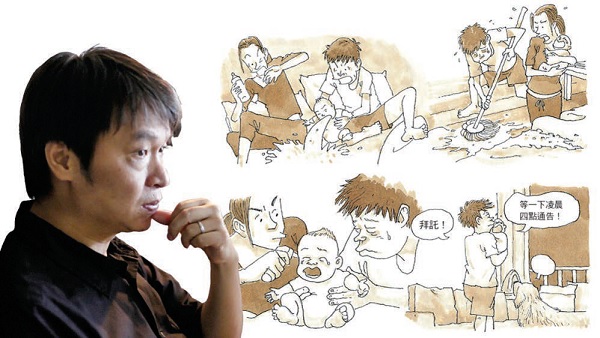
▲Xiao Zhuang and "Dad Etude". (Image Source:https://www.openbook.org.tw/article/p-24075)
Years of working in the fast-paced advertising world have not diminished his patience in working slowly and carefully when creating comics. Xiaozhuang specializes in non-fiction graphic novels, especially the memoir genre. The works carefully present a specific profession (such as advertising or film), or a key historical period (Taiwan's 1980s).
The works are organized like notes or essays, each of which is only about ten pages, such as "Me and My 1980s", "Baseball Fever", "Er Shui's Piano Lessons", and "Super Alloy Robot" in "The 80s Event Book" , "Bruce Lee", "Pressure to enter higher education"... outline the collective memory of the era of looking at the big from the small.
The titles of "Etudes for Dad": "Gaze", "Birth", "Long Night of War Preparation", "Diapers", "Bath"... convey the family affection across time and space from his own experience as a father for the first time. Xiaozhuang said about this work:"Hand-drawing is like writing a letter, a love letter to a child. It records every little thing that may not be a big deal, and gathers it into a unique memory. It tells him that as first-time fathers, we are actually very panicked, and we are still like children. We can only do it for the sake of safety. doSmash a new life, bite the bullet and get strongCome, and then it seems that we have a lifelong intersection through stumbling. Life is about constant practice. "
Xiaozhuang's writing is plain and friendly, with flashes of philosophy from time to time. The painting style has the humorous style of the famous French illustrator Sambey (the illustrator of "Little Naughty Nicholas"), as well as the different camera angle changes in the movie, giving readers a relaxed and not superficial look. Once you watch it, you will be fascinated by it and watch it twice. A rewarding reading experience.
The similarity between Ruan Guangmin and Xiaozhuang is that they start from life, record and reflect on the past, present and future vision of urban and rural Taiwan. Ruan Guangmin tells stories with local emotional heritage, while Xiaozhuang captures inspiration from real historical events, workplace ups and downs, and trivial matters in life. They recently drew different versions of graphic novels for "The Magician on the Skybridge" (original work by Wu Mingyi), a collection of classic short stories set in Taipei's China Mall. Together with the TV series adapted by Public Television, which was well-received and well-received, they work together to revive graphic storytelling. Promote the mainstream market.
Borderless Art Poetry - Animo
If savoring the graphic novels of Xiaozhuang and Ruan Guangmin is like enjoying an authentic roadside stall or exquisite home-cooked food, then opening a book by Animo (1977-), who is younger than them, is more like accidentally drinking it while walking in the countryside. Good coffee in a pottery cup - the irregularly shaped pottery cup becomes more interesting the more you look at it, the bitterness of the coffee has a fruity aroma.
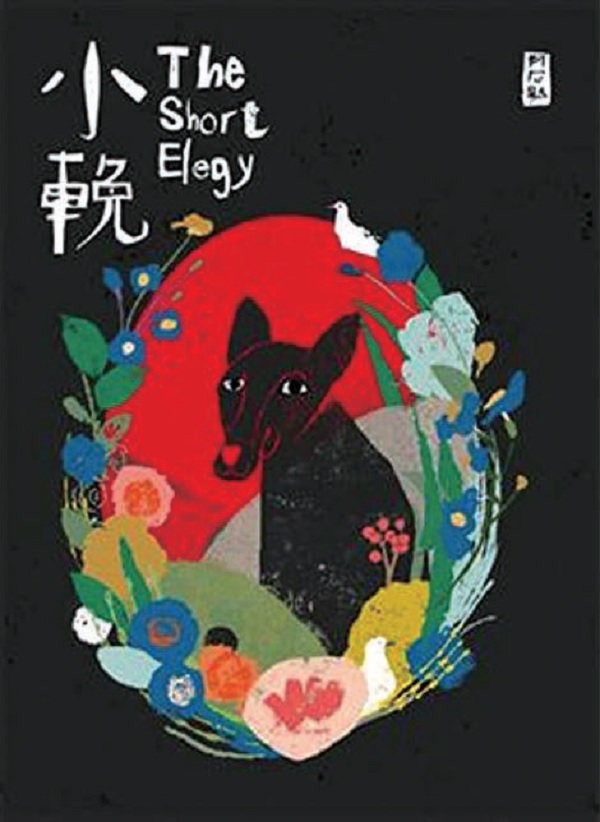
▲Animo's "Little Wan". (Image Source:https://www.goodreads.com/book/show/48663623)
Animo, who graduated from the Department of Visual Communication Design, worked as a still photographer, art director, animation director and paper illustrator before switching to the field of pure art. His material desires are extremely low, his life is simple and simple, and he can go without leaving home for a month when he is deeply involved in creation. When I was 32 years old, I went abroad for further study, not to the United Kingdom, the United States, and Canada that most people are familiar with, but to the Czech Republic in Eastern Europe, where winters are brutally cold and the language is difficult to understand. Why drop everything to go to such a hard place? He said that he wanted to "start over as if he had never learned to paint before."
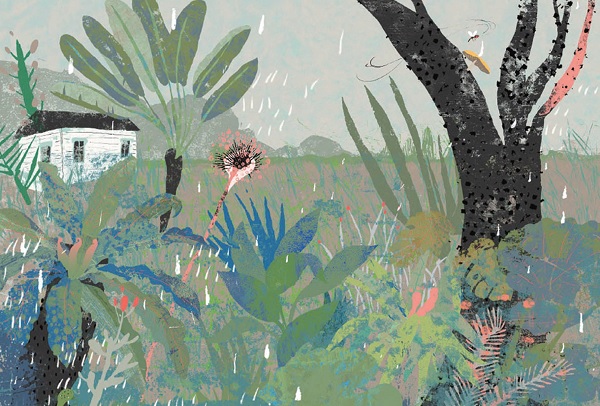
▲The full-color picture of "Little Wan" with high artistic concentration. (Image Source:https://www.openbook.org.tw/article/p-63371)
Perhaps because of the profound experience of language limitations in life in a foreign land, Animo's first graphic novel "Little Wan" has almost no words. It is purely guided by more than 300 full-color pictures with high artistic concentration, extending and impacting the readers' eyes and hearts. Many of the individual paintings make one want to frame them and hang them on the wall, but linked together they are silent films on paper that have a beginning and an end. The peculiar title of "Little Wan", the strange painting style, and the plot that requires careful consideration may not be embraced by all readers at first glance, but it is worth opening your eyes, settling your mood, and slowly entering the three plots gathered in the book. story:
〈Dry Creek〉: The bus hit the bicycle and the passengers got off the bus. A ten-year-old boy lost his way to avoid the crowd of people watching the casualties. When he was taking a rest, he accidentally hit a wild dog on the side of the road and died violently.
〈House Mosquito〉: A female mosquito desperately laying eggs contrasts with a human mother whose baby dies at an early age. The instinct of biological reproduction and the grief of family members are repeated in the picture, and the melody changes from tearing to gradually harmonious.
<ribbon>: Lost love is like a blood-red ribbon, not only wrapped around the woman's black hair, but also wrapped around her heart and every step she takes.
The elegy is like a shadow or a poem, commemorating the big or small encounters with death in life. Different characters walk through the maze of the soul in the dark, and the passing things fall into the soil, nourishing the next seed to sprout.
The review is pertinent: "This book displays a high degree of artistry, as well as complex emotions and strong emotions conveyed by nearly three hundred pages of comic strips. It makes people admire the author's superb drawing skills and narrative skills, as if watching a three-hour movie. , and almost no lines or narration is needed.”
"Little Wan" won the first prize in the new youth comic category of the Ragazzi Award at the Bologna International Book Fair in Italy (one of the four major international book fairs in the world) in 2020. The judges praised it as "a visually concrete poem that conveys ideas that transcend national boundaries and language barriers" and awarded the first prize to Animo without any objection. They also pointed out that this award also "affirms other outstanding works in Taiwan and expands Taiwan's visibility." "
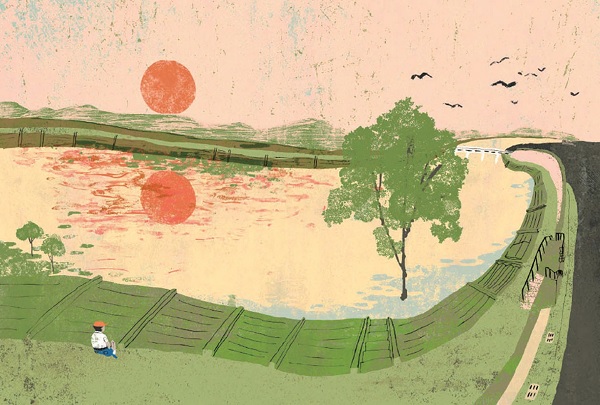
▲"Small Wan" was praised as "a visually concrete poem that conveys ideas that transcend national boundaries and language barriers". (Image Source:https://www.openbook.org.tw/article/p-63371)
Animo said in an interview with the podcast Reading Walkman:"I happened to be lucky enough to get this award, but I have toexplain, there were many, many talented seniors before me who helped us pave a lot of roads. In the end, I won the first prize on behalf of everyone. This was achieved by everyone together. "
Sing a lasting emotion to the world
Growing up in "a beautiful island in the roaring ocean", I have different emotions when reading Taiwanese graphic novels. The creators introduced in this article are not far apart in age from me, and the history, society, and life situations they recorded... are familiar bits and pieces of my hometown. However, the brilliance of these works is not only to relive memories, not only to evoke nostalgia and melancholy accompanied by warmth and sweetness, but also to inspire readers to reflect on the years they have lived and the great things they have experienced through the multiplication of text and pictures in graphic novels. The environment affects the growth process without knowing it. Think deeply and then ask - what possibilities are there for tomorrow?
Ruan Guangmin, Xiaozhuang, and Animo are not just graphic novelists. Their investment in other fields, whether voluntary or out of life needs, does not detract from their concentration in creating comics. On paper, their passion for art and their homeland is revealed. This profound emotion makes their works come alive, making their works not just a fleeting glance without a trace, but a lasting impression.
There is a stubborn longing for goodness in human nature, and the story of the human heart silently longing for light. Xiaozhuang's only fictional work "Window", the soaring white dove in the opening book, "Flowing Light Like Water" (image version of "The Magician on the Bridge") can only be seen by two children, flowing through the river of light in the dark night of Taipei ; In the first chapter of Ruan Guangmin's version of "The Magician on the Bridge", the magician takes off his left eye "like a newborn milky white planet"; in Animo's "Little Wan" "Dry Creek", the boy is covered with soil after facing the fear of death. The corpse of a stray dog is placed with tree branches and Yakult bottles, showing the child's respect and tenderness for life, even the life that has passed away. Isn’t this all about longing for and yearning for light? Only creators who deeply love Taiwan can create graphic works with profound local sentiments. Emotions spill over from the depths of their souls like tears, moistening every word and every stroke. So if there is a creator who is closely connected with the Lord’s grape branch, he will definitely reveal the sweetness of grape juice in the graphic novel!
Do we have many stories worth telling in the Bible and in life? The sporadic creators on the small island of Taiwan, bravely sing to the world; may He arise in your hometown and on every island in the world, graphic novelists who can dance with double-colored pens, write and draw, and spread the word unchangeably in the changing era. Information.
Huang Ruiyi, holds a bachelor's degree in library science from National Taiwan University and a Ph.D. in Chinese education from Ohio State University, specializing in children's and adolescent literature. He has worked in public and private primary and secondary schools in Southern California for many years. He is currently the director of the International Student Department of Youxi Christian School and a senior staff member and teacher of Genesis Literary Training Bookstore. Articles are scattered in Taiwan and North American Christian publications. In the past eight years, he has been the author of two columns, "Awkward Youth Travel" and "Building a Book Bridge over Bad Water" in Taiwan's "Campus" magazine. Participated in the Fairy Tale Lecture Series of the Far Eastern Broadcasting Corporation. I continue to expand my reading horizons with my two older children who love to read.
